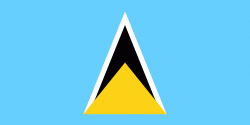Anse la Raye Quarter (Anse-la-Raye)
In French colonial times, Anse la Raye was the sight of sugar plantation, according to a plaque in a park in the town of Anse la Raye erected in 2010. There were as many as 107 estates in Anse la Raye in 1775, according to church records. During the French Revolution, slaves were freed and the name of the town was changed to L'Egalite. Slave were freed and the plantations were burned. Most people abandoned the land and turned towards fishing as a livelihood. Banana and coconut oil production became more important in the mid-20th century, as well as boat building. The area is known for feather racing boats and canoe races. In the late 1990s, a Friday Fish Night became a popular diversion in the town of Anse la Raye.
Severe hurricanes struck Saint Lucia in 1780 and 1817, destroying many ships moored in Anse la Raye.
Map - Anse la Raye Quarter (Anse-la-Raye)
Map
Country - Saint_Lucia
 |
 |
| Flag of Saint Lucia | |
The first proven inhabitants of the island, the Arawaks, are believed to have first settled in AD 200–400. Around 800 AD, the island would be taken over by the Kalinago. The French were the first Europeans to settle on the island, and they signed a treaty with the native Caribs in 1660. England took control of the island in 1663. In ensuing years, England and France fought 14 times for control of the island, and the rule of the island changed frequently. Eventually, the British took full control in 1814. Because the island switched so often between British and French control, Saint Lucia was also known as the "Helen of the West" after the Greek mythological character, Helen of Troy.
Currency / Language
| ISO | Currency | Symbol | Significant figures |
|---|---|---|---|
| XCD | East Caribbean dollar | $ | 2 |
| ISO | Language |
|---|---|
| EN | English language |















